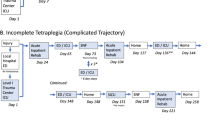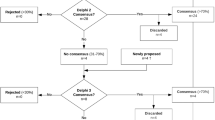Abstract
Study design
Qualitative study.
Objectives
The purpose of this study is to understand the patient perspective after diagnosis of an acute traumatic spinal cord injury (tSCI). Discussing the diagnosis and prognosis of a tSCI with a patient can be a challenging experience for both the patient and the physician. As such, this paper attempts to better understand the patient experience to improve communication when discussing this life-altering injury.
Setting
Vancouver General Hospital, Vancouver, British Columbia, Canada.
Methods
This study is a qualitative study utilizing grounded theory and semi-structured interviews. The interview transcripts were manually coded using manifest and latent content analysis. Major and minor codes were identified and discussed.
Results
In total, 17 interviews were conducted, fifteen individuals with tSCI who received acute care at Vancouver General Hospital (VGH) and eleven family members were interviewed. Patient participants were interviewed individually or in a paired interview with a participating family member. Patient participants had varying spinal cord injuries from AIS A-D. Two major themes were identified from the interviews. The first major theme was physician demeanor (general approach and attitude towards patients) and the second major theme was delivery of information (content, timing, and source).
Conclusions
This study summarizes the preferences of patients who sustained a tSCI discussions regarding their diagnosis and prognosis in the acute care setting. The goal of this study is to help guide physician interactions at this difficult and vulnerable time for patients with hopes to improve patient care through effective communication.
Similar content being viewed by others
Log in or create a free account to read this content
Gain free access to this article, as well as selected content from this journal and more on nature.com
or
Data archiving
The datasets generated during and/or analysed during the current study are not publicly available. Electronic records will be stored on a secure, password-protected hospital server. Hard-copy transcripts and surveys will be kept in locked filing cabinets in a locked office, at the Rick Hansen Institute and/or in the Spine Research Center office, both located at Blusson Spinal Cord Center at Vancouver General Hospital. Only team members approved through ethics will have access to the data.
All transcripts and surveys will be destroyed 5 years after the conclusion of the project. The digital recordings of interviews will be stored on a secure server, and backup copies will be stored on a password-protected external hard drive in a locked filing cabinet at the Blusson Building. Research ethics approval will be sought before any secondary analysis is undertaken.
References
Monden K, Gentry L, Cox TR. Delivering bad news to patients. Proc Bayl Univ Med Cent. 2016;29:101–2. https://doi.org/10.1080/08998280.2016.1=29380.
Buckman R. Breaking bad news: why is it still so difficult? Br Med J (Clin Res Ed). 1984;288:1597–9. https://doi.org/10.1136/bmj.288.6430.1597.
Vandekieft GK. Breaking bad news. Am Fam Physician. 2001;64:1975–9.
Sand A, Karlberg I, Kreuter M. Spinal cord injured persons’ conceptions of hospital care, rehabilitation, and a new life situation. Scand J Occup Ther. 2006;13:183–92.
Garrino L, Curto N, Decorte R. Towards personalized care for persons with spinal cord injury: a study on patients’ perceptions. J Spinal Cord Med. 2001;34:67–75.
Kirshblum S, Fichtenbaum J. Breaking the news in spinal cord injury. J Spinal Cord Med. 2008;31:7–12.
Kirschblum S, Botticello A, DeSipio GB. Breaking the news: a pilot study on patient perspectives of discussing prognosis after traumatic spinal cord injury. J Spinal Cord Med, 2016;39:155–161.
Slavin LA, O’Malley JE, Koocher GP. Communication of the cancer diagnosis to pediatric patients: impact on long-term adjustment. Am J Psychiatry. 1982;139:179–83.
Maynard DW. On “realization” in everyday life: the forecasting of bad news as a social relation. Am Sociological Rev. 1996;61:109–31.
Ford S, Fallowfield L, Lewis S. Doctor-patient interactions in oncology. Soc Sci Med. 1996;42:1511–9.
Butow PN, Dunn SM, Tattersall MH. Communication with cancer patients: does it matter? J Palliat Care. 1995;11:34–8.
Sardell AN, Trierweiler SJ. Disclosing the cancer diagnosis. Procedures that influence patient hopefulness. Cancer. 1993;72:3355–5.
Roberts CS, Cox CE, Reintgen DS. Influence of physician communication on newly diagnosed breast cancer patients’ psychologic adjustment and decision-making. Cancer. 1994;74:336–41.
Strauss A, Corbin J. Grounded Theory Methodology: An Overview. In: Denzin N. K. & Lincoln Y. S., editors. Handbook of Qualitative Research. Thousand Oaks, CA: SAGE; 1994. p. 273–85.
Glaser BG. Doing grounded theory analysis: Issues and discussions. Mill Valley, CA: Sociology Press, 1998.
Noonan VK, Kwon BK, Soril L, Fehlings MG, Hurlbert RJ, Townson A, et al. RHSCIR network. The Rick Hansen Spinal Cord Injury Registry (RHSCIR): a national patient-registry. Spinal Cord. 2012;50:22–7.
Kirshblum SC, Waring W, Biering-Sorensen F, Burns SP, Johansen M, Schmidt-Read M, et al. Reference for the 2011 revision of the international standards for neurological classification of spinal cord injury. J Spinal Cord Med. 2011;34:547–54.
Snyder CR. Reality negotiation: from excuses to hope and beyond. J Soc Clin Psychol. 1989;8:130–57.
Snyder CR. To hope. To lose, to hope again. J Personal Interpers Loss. 1996;1:1–16.
Elliott TR, Witty TE, Herrick S. Negotiating reality after physical loss: hope, depression and disability. J Personal Soc Psychol. 1991;14:608–13.
Acknowledgements
Valerie Oglov for interviewing a subset of the patients and coding the data. Leilani Reichl and Allan Aludino for patient recruitment and enrollment.
Funding
The Praxis Spinal Cord Institute is registered under the Spinal Cord Injury Solutions Network (SCISN), which is a Registered Canadian Charity who receives donations to support spinal cord injury research. Money was received from Praxis to cover the costs related to data collection (contract salary for Oglov V, and gift card incentive for participants in compensation for their time).
Author information
Authors and Affiliations
Contributions
MN was responsible for the study design, interview guide development, literature search, data collection, and paper writing. SS was involved in the paper writing. LB was involved in the study design, interview guide development and paper review. VN was responsible for the study design, interview guide development, literature search, and manuscript review. LH was also involved in the study design, interview guide development, data collection, data recording and storage, as well as the paper review. MB, ND, BK, SP, JS, MD, and CF were all involved in the study design and paper review.
Corresponding author
Ethics declarations
Conflict of interest
The authors declare no competing interests.
Ethics statement
This study was approved by the UBC Behavioral Research Ethics Board prior to commencement of participant recruitment. The reference number for ethics board approval is H13-02355.
Additional information
Publisher’s note Springer Nature remains neutral with regard to jurisdictional claims in published maps and institutional affiliations.
Rights and permissions
About this article
Cite this article
Nadeau, M., Singh, S., Bélanger, L. et al. Patient perspective: diagnosis and prognosis of acute spinal cord injuries. Spinal Cord 59, 865–873 (2021). https://doi.org/10.1038/s41393-021-00641-5
Received:
Revised:
Accepted:
Published:
Issue date:
DOI: https://doi.org/10.1038/s41393-021-00641-5



